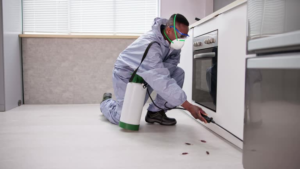Pests of all kinds can infect people and cause serious illness through their faeces, droppings, bites or other excreta. They also damage products and property.

Control of pests often requires an integrated approach. This may include a variety of natural, biological and chemical control methods. It may also involve educational and structural measures. Contact Pest Control Burnaby BCfor professional help.
Residential pest control is a critical part of keeping a safe and healthy living environment for families. Many pests carry diseases, cause property damage, and can create a dangerous and uncomfortable home environment for children, seniors, and people with allergies or other health conditions. Professional pest control services have the experience, knowledge, and tools to effectively eliminate pest infestations and prevent them from returning.
Regular pest inspections can help identify signs of infestation before it becomes a serious problem. Signs to look out for include droppings, urine stains, chewed electrical wires or furniture, gnaw marks in wood or furniture, and unusual odors. Unusual sounds like scurrying, chirping, or buzzing can also indicate the presence of unwanted pests in your home.
Taking immediate action to address a pest infestation can prevent it from getting out of hand. Some pests reproduce rapidly, and if not treated in time, they can spread throughout your entire house. Using targeted treatments, your pest control technician can break the reproduction cycle and protect your property from more serious damage.
Routine pest control can also help preserve the value of your property. Infestations of termites, cockroaches, rats, and other rodents can damage furniture, wooden structures, and other valuable items. By identifying and addressing pest problems as they occur, you can avoid costly repairs and replacements.
Pest control professionals use a combination of methods to keep pests out of your home, including traps, baits, and repellents. In addition, they can provide advice on how to make your home less appealing to pests in the future.
A career in pest control is a great choice for anyone who enjoys being outdoors, wants to work on their own schedule, and has a strong sense of responsibility. It can be an extremely rewarding job, as it allows you to help people improve their lives by eliminating dangerous pests. However, it is important to remember that the success of your business depends on your ability to adapt to different situations and handle criticism.
If you’re interested in a career in pest control, consider the following tips to ensure that you have a successful and fulfilling experience.
Commercial
Businesses of all sizes and industries are vulnerable to pest infestations, which can result in loss of product or revenue, costly repair bills and a tarnished reputation. For this reason, commercial facilities require proactive pest control strategies that go beyond merely exterminating unwanted critters when they appear. A quality provider of commercial pest control services will focus on a preventative approach known as pest exclusion, which involves sealing entry points to a building or facility and removing hiding spots where pests like cockroaches, ants, rodents and fleas may hide.
Restaurants, food processing facilities and retail spaces are some of the most common commercial environments plagued by pests. These spaces are rife with potential entry points through cracks in the foundation, unsecured vents, poorly sealed drain pipes and open garbage shoots. A professional commercial pest control service will conduct a thorough inspection of the building and its surroundings to identify vulnerable entry points, then fortify those areas with caulk or other materials.
Medical facilities, such as hospitals, long-term care or emergency medical centers, and mental and physical rehabilitation centers, must adhere to the highest standards of cleanliness and hygiene to protect their patients’ health. Due to the nature of their work, these facilities are more susceptible to pest infestations than other types of commercial spaces. Pests can spread disease, contaminate surfaces and equipment, and cause illnesses in patients. Commercial pest control services ensure these facilities are proactively protected from harmful critters that can pose a serious threat to patient safety.
Business offices, warehouses and storage units often serve as the ideal nesting spots for a variety of pests, including cockroaches, ants, termites, fleas and rodents. Such abrasive insects and rodents can cause significant damage to stored products and structural integrity, and their droppings and shed skin can trigger allergies and respiratory problems in employees and customers. Moreover, their presence can damage a company’s reputation in the eyes of the public and lead to fines and closures from local, state and federal health or sanitation agencies.
In today’s competitive marketplace, a company’s reputation is everything. Just one pest sighting or infestation can damage a company’s image, and prompt customers to look elsewhere for goods and services. A reliable pest control service will provide discreet and effective pest management, preserving a company’s reputation and boosting customer confidence.
Industrial
Industrial facilities, including warehouses, distribution centers, manufacturing plants, and food processing facilities, offer ideal conditions for pests to thrive. From rodents and insects to birds, stored product pests and warehouse beetles, pest infestations in industrial settings can pose significant problems for facility operations, equipment, and products. Effective pest management is critical to safeguarding the integrity of materials, ensuring product quality and safety, maintaining compliance with regulations, and protecting human health and worker safety.
The complexities of industrial settings make them more challenging to treat than residential and commercial properties. Industrial spaces may have extensive storage areas, specialized equipment, and multiple entry points. A thorough inspection, customized treatment approach, and ongoing monitoring are essential to designing effective pest control programs for industrial environments.
Many of the same pest control products available to homeowners can be used in industrial settings. The difference is that professional pest control companies are licensed, certified, and trained to use these products responsibly for optimum effectiveness and to ensure the safest environment for employees, customers, and the public. Professionals have the experience and specialized equipment to apply these products in tight spaces and difficult-to-reach areas where pests hide. In addition, professional pest control providers know how to properly mix and apply chemicals for the most effective results with a minimum of environmental impact.
Regular inspections and implementing preventive measures are the most effective approaches for industrial pest control. Sealing entry points, removing moisture and debris, and limiting clutter can prevent pests from entering or breeding inside facilities. Routine cleaning and sanitation practices are also vital to maintaining pest-free facilities. Educating employees on proper hygiene practices and reporting pest sightings can also help control infestations before they get out of hand.
Integrated Pest Management (IPM) is an effective pest management strategy that utilizes prevention, monitoring, and targeted interventions to manage pests in industrial settings. IPM uses a combination of methods, including sanitation, exclusion, biological control, and structural modification to reduce the need for chemical pesticides. IPM is often used in conjunction with a variety of other strategies, including baits and traps, for comprehensive pest control.
Agriculture
Providing the world with food, fiber and fuel requires a delicate balance between nurturing crops and fending off pests. This balance is essential to human civilization, but it also puts agriculture at risk of severe damage. With reduced effectiveness due to resistance, fewer new products in development, and restrictions placed on chemical use, it’s clear that we need a new approach.
The CSIRO is working to catalyze new innovation in agripest control, using the best science and technology to support farmers as they make changes to reduce their reliance on chemicals. Our approach is to work with multiple partners across Australia, and to focus on the key farming system factors that drive agrichemical over-reliance. The first step is to codevelop a strategic national research agenda.
This will help reorient agripest management science toward addressing key farming system challenges. For example, our research shows that a change from conventional to sustainable farming practices can have a significant impact on crop protection. This would involve a move from broad-spectrum pesticides to more targeted biopesticides. This could include plant-derived botanicals, molecular tools (e.g. vaccines or peptides) and genetic engineering to target specific pathogens or pests.
Another strategy is to introduce natural enemies from a pest’s native habitat, after careful testing to ensure that they won’t harm non-target species. This approach is known as classical biological control, and it has been used successfully against invasive pest species like cottony cushion scale.
Cultural practices are also an important part of any integrated pest management strategy. Planting crops together that enhance one another’s growth and repel pests is an example of this technique. Other cultural methods include maintaining good sanitation practices, such as removing weeds and crop residues from fields. This helps prevent pests from finding shelter and food.

